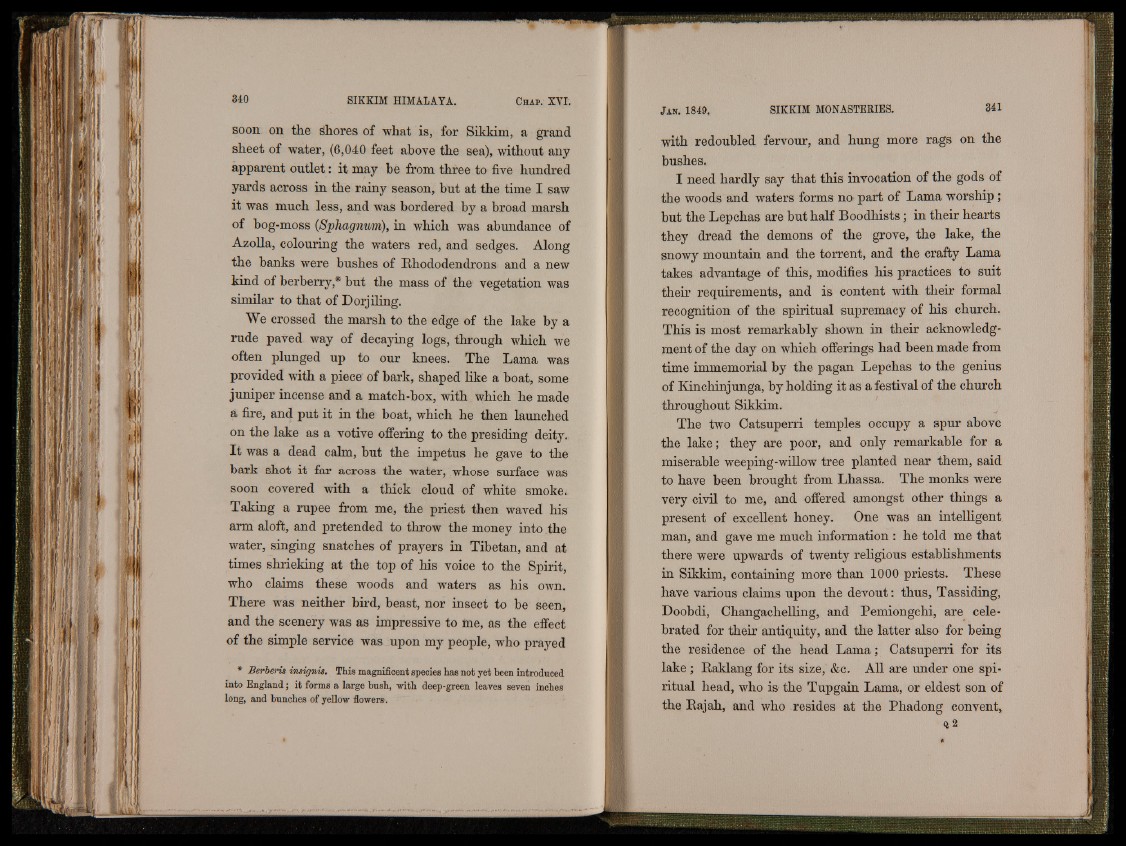
soon on the shores of what is, for Sikkim, a grand
sheet of water, (6,040 feet above the sea), without any
apparent outlet: it may be from three to five hundred
yards across in the rainy season, but at the time I saw
it was much less, and was bordered by a broad marsh
of bog-moss (Sphagnum), in which was abundance of
Azolla, colouring the waters red, and sedges. Along
the banks were bushes of Rhododendrons and a new
kind of berberry,* but the mass of the vegetation was
similar to that of Dorjiling.
We crossed the marsh to the edge of the lake by a
rude paved way of decaying logs, through which we
often plunged up to our knees. The Lama was
provided with a piece of bark, shaped like a boat, some
jumper incense and a match-box, with which he made
a fire, and put it in the boat, which he then launched
on the lake as a votive offering to the presiding deity.
I t was a dead calm, but the impetus he gave to the
bark shot it far across the water, whose surface was
soon covered with a thick cloud of white smoke.
Taking a rupee from me, the priest then waved his
arm aloft, and pretended to throw the money into the
water, singing snatches of prayers in Tibetan, and at
times shrieking at the top of his voice to the Spirit,
who claims these woods and waters as his own.
There was neither bird, beast, nor insect to be seen,
and the scenery was as impressive to me, as the effect
of the simple service was upon my people, who prayed
* Berber!» msignis. This magnificent species has not yet been introduced
into England; it forms a large bush, with deep-green leaves seven inches
long, and bunches of yellow flowers .
with redoubled fervour, and hung more rags on the
bushes.
I need hardly say that this invocation of the gods of
the woods and waters forms no part of Lama worship;
but the Lepchas are but half Boodhists; in their hearts
they dread the demons of the grove, the lake, the
snowy mountain and the torrent, and the crafty Lama
takes advantage of this, modifies his practices to suit
their requirements, and is content with their formal
recognition of the spiritual supremacy of his church.
This is most remarkably shown in their acknowledgment
of the day on which offerings had been made from
time immemorial by the pagan Lepchas to the genius
of Kinchinjunga, by holding it as a festival of the church
throughout Sikkim.
The two Catsuperri temples occupy a spur above
the lake; they are poor, and only remarkable for a
miserable weeping-willow tree planted near them, said
to have been brought from Lhassa. The monks were
very civil to me, and offered amongst other things a
present of excellent honey. One was an intelligent
man, and gave me much information : he told me that
there were upwards of twenty religious establishments
in Sikkim, containing more than 1000 priests. These
have various claims upon the devout: thus, Tassiding,
Doobdi, Changachelling, and Pemiongchi, are celebrated
for their antiquity, and the latter also for being
the residence of the head Lama; Catsuperri for its
lake ; Raklang for its size, &c. All are under one spiritual
head, who is the Tupgain Lama, or eldest son of
the Rajah, and who resides at the Phadong convent,